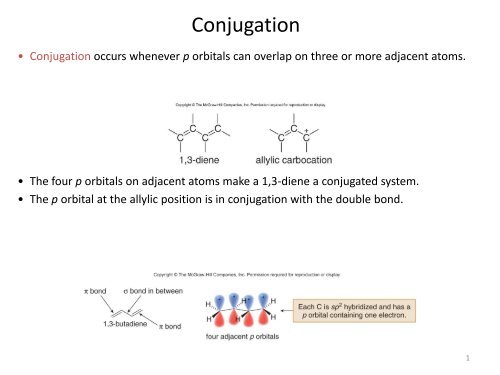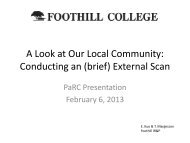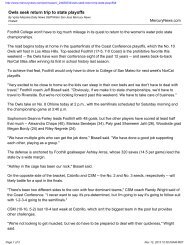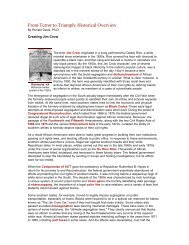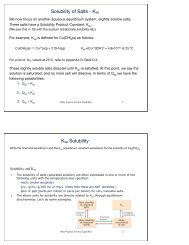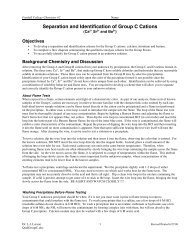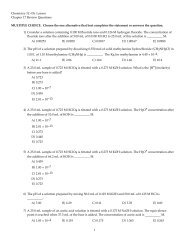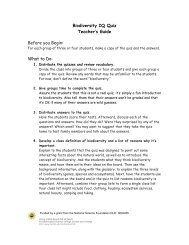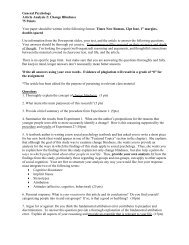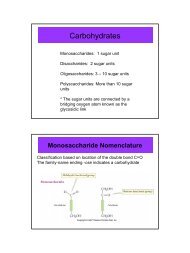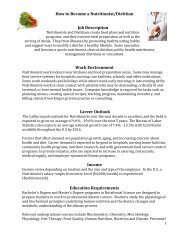Conjugation
Conjugation
Conjugation
Create successful ePaper yourself
Turn your PDF publications into a flip-book with our unique Google optimized e-Paper software.
<strong>Conjugation</strong><br />
• <strong>Conjugation</strong> occurs whenever p orbitals can overlap on three or more adjacent atoms.<br />
• The four p orbitals on adjacent atoms make a 1,3-diene a conjugated system.<br />
• The p orbital at the allylic position is in conjugation with the double bond.<br />
1
Delocalization<br />
• Having three or more p orbitals on adjacent atoms allows p orbitals to overlap and<br />
electrons to delocalize.<br />
2
• 1,4-Pentadiene is an isolated diene.<br />
Dienes<br />
• The bonds in 1,4-pentadiene are too far apart to be conjugated and are isolated from<br />
each other by a sp 3 carbon.<br />
3
<strong>Conjugation</strong> of Allylic Cations<br />
• The allyl carbocation is another example of a conjugated system.<br />
• <strong>Conjugation</strong> stabilizes the allyl carbocation.<br />
4
Delocalized Hybrids<br />
• Drawing resonance structures for the allyl carbocation is a way to<br />
illustrate how conjugation delocalizes electrons.<br />
• The true allyl cation is a hybrid of the two resonance forms.<br />
• In the hybrid, the positive charge is delocalized over the two terminal<br />
carbons.<br />
• Delocalizing the charge stabilizes the allyl carbocation, making it more<br />
stable than a normal 1° carbocation.<br />
5
• Experimental data show that the stability of the allyl cation is<br />
comparable to a more highly substituted 2° carbocation.<br />
Figure 16.3<br />
13 C chemical shifts<br />
for a localized and a<br />
resonance-stabilized<br />
carbocation<br />
Stability of Allyl Cations<br />
6
Common Examples of Resonance<br />
Type [1] The Three Atom “Allyl” System, X = Y − Z*<br />
Examples are the allyl cation and the acetate anion. The two resonance<br />
structures differ in the location of the double bond, and either the charge, the<br />
radical, or the lone pair, generalized by [*].<br />
7
Common Examples of Resonance<br />
Type [2] Conjugated Double Bonds<br />
• Cyclic, completely conjugated rings like benzene have two resonance<br />
structures, drawn by moving the electrons in a cyclic manner around the<br />
ring.<br />
• Three resonance structures can be drawn for other conjugated dienes,<br />
two of which involve separation of charge.<br />
8
Type [3] Cations Having a Positive Charge Adjacent to a<br />
Lone Pair<br />
Common Examples of Resonance<br />
• The overall charge is the same in both resonance structures.<br />
• Based on formal charge, a neutral X in one structure must bear a (+)<br />
charge in the other.<br />
9
Common Examples of Resonance<br />
Type [4] Double Bonds Having One Atom More<br />
Electronegative Than the Other<br />
10
The Resonance Hybrid is a Combination of<br />
Resonance Forms<br />
• The actual hybrid resembles the most stable resonance structure(s).<br />
• Three rules guide the assessment of the relative stability of resonance<br />
structures.<br />
11
Resonance Hybrid Contributions<br />
12
Determining Resonance Structure<br />
There are two Lewis structures (A and B) for the resonance- stabilized<br />
anion (CH 3COCH 2) - .<br />
• Based on structure A, the indicated carbon is sp 3 hybridized, with the lone<br />
pair of electrons in an sp 3 hybrid orbital.<br />
• Based on structure B, however, it is sp 2 hybridized with the unhybridized p<br />
orbital forming the portion of the double bond.<br />
13
p Orbitals Required for <strong>Conjugation</strong><br />
• The electron pair on the carbon atom adjacent to the C=O can only be<br />
delocalized if it has a p orbital that can overlap with two other p<br />
orbitals on two adjacent atoms.<br />
• Thus, the terminal carbon atom is sp 2 hybridized with trigonal planar<br />
geometry.<br />
• Three adjacent p orbitals make the anion conjugated.<br />
• The actual hybrid has more of the charge on the oxygen and more C=C<br />
double bond character.<br />
14
Conjugated Dienes<br />
• Conjugated dienes are compounds having two double bonds joined<br />
by one bond.<br />
• Conjugated dienes are also called 1,3-dienes.<br />
• 1,3-Butadiene (CH 2=CH-CH=CH 2) is the simplest conjugated diene.<br />
• Three stereoisomers are possible for 1,3-dienes with alkyl groups<br />
bonded to each end carbon of the diene.<br />
15
Conformation of Conjugated Dienes<br />
• Two possible conformations result from rotation around the C–C bond<br />
that joins the two double bonds.<br />
• Stereoisomers are discrete molecules, whereas conformations<br />
interconvert.<br />
16


